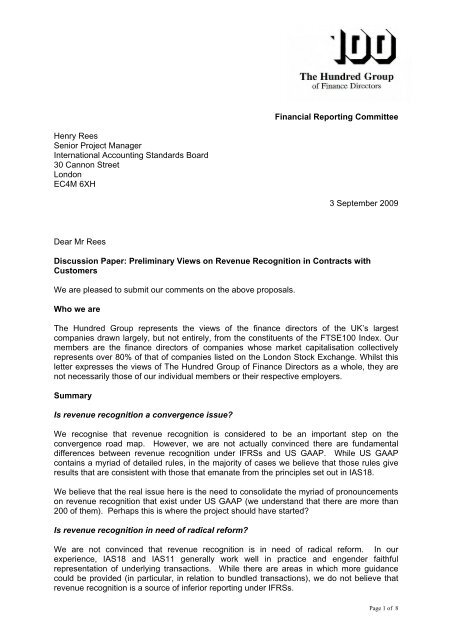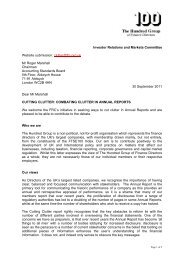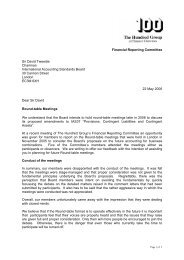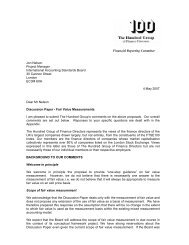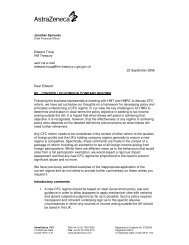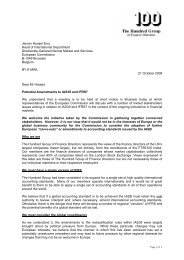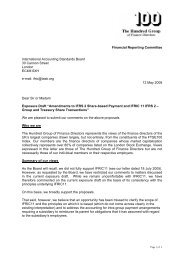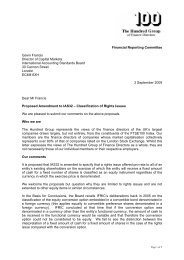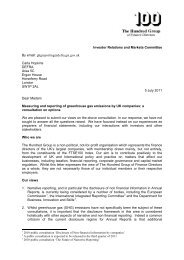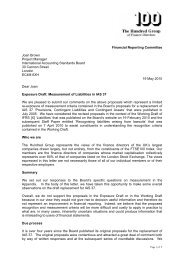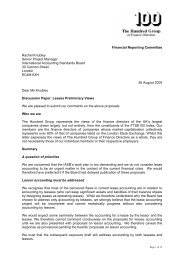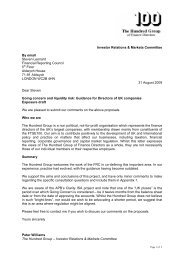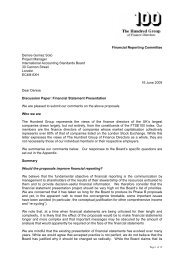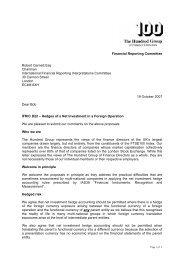Financial Reporting Committee Henry Rees Senior Project Manager ...
Financial Reporting Committee Henry Rees Senior Project Manager ...
Financial Reporting Committee Henry Rees Senior Project Manager ...
Create successful ePaper yourself
Turn your PDF publications into a flip-book with our unique Google optimized e-Paper software.
<strong>Henry</strong> <strong>Rees</strong><br />
<strong>Senior</strong> <strong>Project</strong> <strong>Manager</strong><br />
International Accounting Standards Board<br />
30 Cannon Street<br />
London<br />
EC4M 6XH<br />
Dear Mr <strong>Rees</strong><br />
<strong>Financial</strong> <strong>Reporting</strong> <strong>Committee</strong><br />
3 September 2009<br />
Discussion Paper: Preliminary Views on Revenue Recognition in Contracts with<br />
Customers<br />
We are pleased to submit our comments on the above proposals.<br />
Who we are<br />
The Hundred Group represents the views of the finance directors of the UK’s largest<br />
companies drawn largely, but not entirely, from the constituents of the FTSE100 Index. Our<br />
members are the finance directors of companies whose market capitalisation collectively<br />
represents over 80% of that of companies listed on the London Stock Exchange. Whilst this<br />
letter expresses the views of The Hundred Group of Finance Directors as a whole, they are<br />
not necessarily those of our individual members or their respective employers.<br />
Summary<br />
Is revenue recognition a convergence issue?<br />
We recognise that revenue recognition is considered to be an important step on the<br />
convergence road map. However, we are not actually convinced there are fundamental<br />
differences between revenue recognition under IFRSs and US GAAP. While US GAAP<br />
contains a myriad of detailed rules, in the majority of cases we believe that those rules give<br />
results that are consistent with those that emanate from the principles set out in IAS18.<br />
We believe that the real issue here is the need to consolidate the myriad of pronouncements<br />
on revenue recognition that exist under US GAAP (we understand that there are more than<br />
200 of them). Perhaps this is where the project should have started?<br />
Is revenue recognition in need of radical reform?<br />
We are not convinced that revenue recognition is in need of radical reform. In our<br />
experience, IAS18 and IAS11 generally work well in practice and engender faithful<br />
representation of underlying transactions. While there are areas in which more guidance<br />
could be provided (in particular, in relation to bundled transactions), we do not believe that<br />
revenue recognition is a source of inferior reporting under IFRSs.<br />
Page 1 of 8
Are the proposals consistent with the Conceptual Framework?<br />
We agree with the boards that in many instances the proposed revenue recognition model<br />
will cause little, if any, change. However, we are very concerned that in the instances where<br />
the proposed model does cause a change, this change is so fundamental that the entity’s<br />
reported revenue will cease to provide decision-useful information about the performance of<br />
the entity. In such cases, the proposals would be inconsistent with the objective of financial<br />
reporting proposed by the boards in the recent exposure draft on Chapter 1 of the<br />
Conceptual Framework.<br />
The boards consider that an entity should only recognise revenue (and therefore profit) once<br />
the customer controls the item. For many companies involved in the provision of long term<br />
contract or service arrangements this could result in the deferral of revenue (and profit) until<br />
the end of the contract. In such cases, an entity’s reported profit would be driven by the<br />
completion dates of contracts and not by the activities of the entity in the period up to<br />
completion, i.e. by the legal form of the contract rather than its economic substance. We<br />
contend that the financial statements prepared on this basis would provide users of the<br />
accounts with little decision-useful information in the intervening reporting periods and would<br />
therefore fail to satisfy the objective of financial reporting that is proposed by the boards.<br />
Moreover, we fail to see how this approach would faithfully represent the underlying<br />
transactions and are concerned that it would not be consistent with the qualitative<br />
characteristics of financial information set out in the recent exposure draft on Chapter 2 of<br />
the Conceptual Framework.<br />
Can one size fit all?<br />
We are conscious that the proposals cause difficulties where they are applied to long-term<br />
contracts and that this is a consequence of attempting to find one method of revenue<br />
recognition that fits all contracts. While this may be technically pure, we urge the boards to<br />
reconsider whether it is a) necessary and b) practicable to find one basis of revenue<br />
recognition that fits all contracts.<br />
We would reiterate that we the basis of recognising revenue on long term contracts has<br />
worked reasonably well for many years and is accepted and understood by users. We are<br />
concerned that the proposed treatment of long-term contracts would result in structuring of<br />
contracts in order to achieve an appropriate spreading of revenue over the term of the<br />
contract.<br />
Other comments<br />
In overview:<br />
• We welcome the boards’ conclusion that revenue should be measured based on the<br />
transaction price (i.e. the consideration receivable) and that they have moved away from<br />
a fair value approach.<br />
• We are concerned that by basing the accounting on the legal form rather than the<br />
economic substance of transactions, the proposals do not reflect the way in which<br />
management typically assesses and monitors performance on contracts internally, thus<br />
creating a difference between revenue recognised for internal and external reporting<br />
purposes;<br />
• We are concerned that the proposals add complexity at a time when users and preparers<br />
of financial statements crave simplicity. For example, the distinction between “control”<br />
and “risk and rewards” is unclear, more clarity is needed on segregating and combining<br />
performance obligations, and the proposals for revenue deferrals (in instances of<br />
Page 2 of 8
warranties etc) are more complex than the approach to provisioning under the current<br />
IAS37;<br />
• We are concerned that the discussion paper has not considered many of the fundamental<br />
issues that typically arise in relation to long-term contracts such as claims, variations and<br />
changes to margin throughout the contract life; and<br />
• We do not see much evidence of the boards having considered the cost-benefit<br />
implications of the proposals.<br />
The way forward<br />
We believe that the first step in this project should have been for the FASB to consolidate its<br />
rules on revenue recognition (we expect that this will now have been achieved by way of the<br />
recently completed codification of US GAAP). Having achieved that, the boards could<br />
address any significant differences that exist between their standards and identify what<br />
changes or additional guidance is required in their respective standards in order to achieve<br />
convergence.<br />
We do not believe that now is the right time to consider radical change in the basis of<br />
revenue recognition and we view any change that would emphasise legal form over<br />
economic substance to be a retrograde step.<br />
We therefore urge the boards not to proceed with the proposals in their current form.<br />
Please feel free to contact me if you wish to discuss our comments.<br />
Yours sincerely<br />
Chris Lucas<br />
Chairman<br />
The Hundred Group - <strong>Financial</strong> <strong>Reporting</strong> <strong>Committee</strong><br />
Page 3 of 8
Question 1<br />
APPENDIX<br />
Do you agree with the boards’ proposal to base a single revenue recognition principle<br />
on changes in an entity’s contract asset or contract liability? Why or why not? If not,<br />
how would you address the inconsistency in existing standards that arises from<br />
having different revenue recognition principles?<br />
The area of revenue recognition is complex, as it cuts across a significant variety of revenue<br />
generating activities. We therefore wonder whether it is possible to develop one model that<br />
provides decision-useful information for all sectors.<br />
The boards consider that an entity should only recognise revenue (and therefore profit) once<br />
the customer controls the item. For many companies involved in the provision of long term<br />
contract or service arrangements this could result in the deferral of revenue (and profit) until<br />
the end of the contract. In such cases, an entity’s reported profit would be driven by the<br />
completion dates of contracts and not by the activities of the entity in the period up to<br />
completion, i.e. by the legal form of the contract rather than its economic substance. We<br />
contend that the financial statements prepared on this basis would provide users of the<br />
accounts with little decision-useful information in the intervening reporting periods and would<br />
therefore fail to satisfy the objective of financial reporting that is proposed by the boards.<br />
Moreover, we fail to see how this approach would faithfully represent the underlying<br />
transactions and are concerned that it would not be consistent with the qualitative<br />
characteristics of financial information set out in the recent exposure draft on Chapter 2 of<br />
the Conceptual Framework.<br />
Question 2<br />
Are there any types of contracts for which the boards’ proposed principle would not<br />
provide decision-useful information? Please provide examples and explain why? What<br />
alternative principle do you think is more useful in those examples?<br />
We do not believe that decision useful information will be achievable for enterprises involved<br />
in construction-type or other long-term contracts.<br />
As set out in the examples to the discussion paper, two contracts to construct a building<br />
would have very different accounting consequences where a contractor undertakes the same<br />
activities through:<br />
(a) a progressive handover of phases of the building; or<br />
(b) a handover of the asset at the end of the entire building.<br />
The economic and commercial substance of these transactions are often the same and this<br />
should be the primary consideration. We do not believe that the contractual form should be<br />
the driving force.<br />
Indeed, should these proposals be accepted, we would envisage considerable changes to<br />
the terms of construction contracts to achieve a whole-life revenue recognition policy. This is<br />
yet another example of the “accountants wagging the commercial tail”.<br />
Page 4 of 8
Question 3<br />
Do you agree with the boards’ definition of a contract? Why or why not? Please<br />
provide examples of jurisdictions or circumstances in which it would be difficult to<br />
apply that definition.<br />
We agree with the Boards’ definition, but note that it is different (in words at least) to the<br />
definition of contracts used elsewhere in IFRS (most notably IAS 32.13) and therefore we<br />
would encourage consistency.<br />
Question 4<br />
Do you think the boards’ proposed definition of a performance obligation would help<br />
entities to identify consistently the deliverables in (or components of) a contract? Why<br />
or why not? If not, please provide examples of circumstances in which applying the<br />
proposed definition would inappropriately identify or omit deliverables in (or<br />
components of) the contract.<br />
As noted above, we believe that the boards’ definition of a performance obligation is too<br />
legalistic.<br />
Take, for example, a contract to construct a building. In practice, the performance of the<br />
contractor is measured on an ongoing basis – through the certification of works completed by<br />
the customer quantity surveyor. This practice occurs for cash flow purposes (the certification<br />
releases a payment by the customer to the contractor). In this scenario, the contractor has<br />
clearly provided physical performance (up to a specified cash amount) to the satisfaction of<br />
the customer but legal performance, through practical completion, will not occur until the end<br />
of the contract.<br />
In our view preparers and users of accounts, along with contractors and customers are<br />
satisfied that the performance obligation is being met throughout the contract life. However,<br />
the boards’ definition would indicate that no performance obligation had been met.<br />
To achieve the boards’ definition, a contract could be legally segregated into a number of<br />
constituent parts to achieve numerous performance obligations. However this is often<br />
impractical for large, complex construction contracts, difficult to administer, and difficult to<br />
account for (at the very least adding a significant degree of complexity).<br />
Question 5<br />
Do you agree that an entity should separate the performance obligations in a contract<br />
on the basis of when the entity transfers the promised assets to the customer? Why or<br />
why not? If not, what principle would you specify for separating performance<br />
obligations?<br />
No, in our view the separation of contracts (or unbundling) should be driven by a range of<br />
factors, including risk profile and not a measure of physical possession. We note that current<br />
guidance under US GAAP (and IAS 11 to a lesser extent) provides better indicators of how to<br />
separate bundled elements.<br />
Page 5 of 8
Question 6<br />
Do you think that an entity’s obligation to accept a returned good and refund the<br />
customer’s consideration is a performance obligation? Why or why not?<br />
Where goods are sold with a right of return, the approach currently adopted by IAS 18<br />
recognises revenue only where it is possible to estimate reliably the proportion that will be<br />
returned. This approach works well in practice and results in understandable and decisionuseful<br />
information. We would encourage the boards to develop a Standard that preserves the<br />
benefits of the existing Standard.<br />
Question 7<br />
Do you think that sales incentives (eg discounts on future sales, customer loyalty<br />
points and ‘free’ good and services) give rise to performance obligations if they are<br />
provided in a contract with a customer? Why or why not?<br />
See response to question 6.<br />
Question 8<br />
Do you agree that an entity transfers an asset to a customer (and satisfies a<br />
performance obligation) when the customer controls the promised good or when the<br />
customer receives the promised service? Why or why not? If not, please suggest an<br />
alternative for determining when a promised good or service is transferred.<br />
As outlined above, we are concerned that the concept of control focuses too much on the<br />
legal form, rather than the economic substance.<br />
It is also unclear from the draft the interaction between “control” and “risks and rewards” – we<br />
raised similar concerns in our comment letter to ED10.<br />
Question 9<br />
The boards propose that an entity should recognise revenue only when a performance<br />
obligation is satisfied. Are there contracts for which that proposal would not provide<br />
decision-useful information? If so, please provide examples.<br />
Please refer to our response to question 2.<br />
Question 10<br />
In the boards’ proposed model, performance obligations are measured initially at the<br />
original transaction price. Subsequently, the measurement of a performance<br />
obligation is updated only if it is deemed onerous.<br />
(a) Do you think that performance obligations should be measured initially at the<br />
transaction price? Why or why not?<br />
Yes.<br />
Page 6 of 8
(b) Do you agree that a performance obligation should be deemed onerous and<br />
remeasured to the entity’s expected costs of satisfying the performance<br />
obligation if that cost exceeds the carrying amount of the performance<br />
obligation? Why or why not?<br />
We believe that a performance obligation is deemed onerous if the expected cost to satisfy<br />
the obligation exceeds the carrying amount of the obligation (this is akin to the current IAS 11<br />
model). However a more useful accounting answer is provided when this test is based upon<br />
assessing the outstanding performance obligations of the entire contract in aggregate.<br />
(c) Do you think that there are some performance obligations for which the<br />
proposed measurement approach would not provide decision-useful information<br />
at each financial statement date? Why or why not? If so, what characteristic of<br />
the obligations makes that approach unsuitable? Please provide examples.<br />
Please refer to our response to question 2.<br />
(d) Do you think that some performance obligations in a revenue recognition<br />
standard should be subject to another measurement approach? Why or why<br />
not? If so, please provide examples and described the measurement approach<br />
you would use.<br />
We agree with the scope exclusions within the draft (para S11).<br />
Question 11<br />
The boards propose that an entity should allocate the transaction price at contract<br />
inception to the performance obligations. Therefore, any amounts that an entity<br />
charges customers to recover any costs of obtaining the contract (eg selling costs)<br />
are included in the initial measurement of the performance obligations. The boards<br />
propose that an entity should recognise those costs as expenses, unless they qualify<br />
for recognition as an asset in accordance with other standards.<br />
(a) Do you agree that any amounts an entity charges a customer to recover the<br />
costs of obtaining the contract should be included in the initial measurement of<br />
an entity’s performance obligations? Why or why not?<br />
Yes.<br />
(b) In what cases would recognising contract origination costs as expenses as they<br />
are incurred not provide decision-useful information about an entity’s financial<br />
position and financial performance? Please provide examples and explain why.<br />
Contract bid costs can be hugely significant in many industries and therefore expensing such<br />
costs, as incurred, does not appear to reflect the integral nature of these costs in fulfilling the<br />
performance obligation.<br />
Such tender costs can include initial design work, site feasibility studies, programme<br />
assessments etc. Additionally, the agreed contract consideration will include an amount for<br />
such costs. Whilst the concept of “matching” is not included within IFRS, recording expenses<br />
in periods different to revenue earned in respect of those expenses would give a peculiar and<br />
inappropriate result.<br />
Page 7 of 8
Question 12<br />
Do you agree that the transaction price should be allocated to the performance<br />
obligations on the basis of the entity’s stand-alone selling prices of the goods or<br />
services underlying those performance obligations? Why or why not? If not, on what<br />
basis would you allocate the transaction price?<br />
Yes, as standalone prices should provide an allowance for the differing risk profile of each<br />
performance obligation.<br />
Question 13<br />
Do you agree that if an entity does not sell a good or a service separately, it should<br />
estimate the stand-alone selling price of that good or service for purposes of<br />
allocation the transaction price? Why or why not? When, if ever, should the use of<br />
estimates be constrained?<br />
Where it is relevant (ie where the entity’s practice is to sell components separately) then,<br />
price, we believe estimates should be used to allocate the transaction price. The use of<br />
estimates in accounting is well established, for instance the use of future forecast cashflows,<br />
which are inherently uncertain, in areas such as impairment testing. While estimates are<br />
inevitably subjective this does not preclude them from providing reliable information if careful<br />
consideration is given to the assumptions on which they are based.<br />
Page 8 of 8


